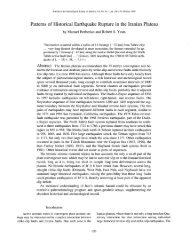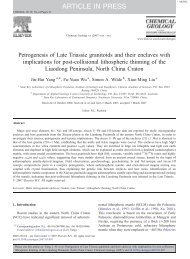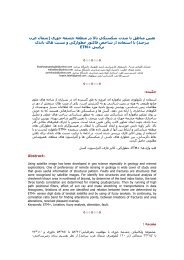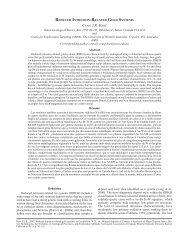Subevent analysis for the Tabas earthquake of September 16, 1978 ...
Subevent analysis for the Tabas earthquake of September 16, 1978 ...
Subevent analysis for the Tabas earthquake of September 16, 1978 ...
You also want an ePaper? Increase the reach of your titles
YUMPU automatically turns print PDFs into web optimized ePapers that Google loves.
10 I. Sarkar et al. / Physics <strong>of</strong> <strong>the</strong> Earth and Planetary Interiors xxx (2005) xxx–xxx<br />
While <strong>Tabas</strong> lies closest to <strong>the</strong> nor<strong>the</strong>rn end <strong>of</strong> <strong>the</strong><br />
NNW–SSE trending ruptures, on <strong>the</strong> northwestern<br />
side, all <strong>the</strong> o<strong>the</strong>r eight stations are located on <strong>the</strong><br />
nor<strong>the</strong>ast/sou<strong>the</strong>astern side <strong>of</strong> <strong>the</strong>se ruptures at varying<br />
distances from <strong>the</strong>se. Amongst this second set <strong>of</strong> eight<br />
stations, Deyhook, located closest to <strong>the</strong> epicenter <strong>of</strong><br />
<strong>the</strong> main sub-event, from where <strong>the</strong> rupture process<br />
presumably initiated, is at <strong>the</strong> sou<strong>the</strong>astern end <strong>of</strong> <strong>the</strong><br />
rupture. The o<strong>the</strong>r seven stations are scattered at larger<br />
distances. Boshroyeh and Ferdows are aligned along<br />
a line almost perpendicular to <strong>the</strong> general strike <strong>of</strong><br />
<strong>the</strong> surface ruptures and situated 70 km and 113 km,<br />
respectively away from <strong>the</strong>se. The o<strong>the</strong>r five stations<br />
(Khezri, Bajestan, Sedeh, Birjand and Kashmar) are<br />
far<strong>the</strong>r away from <strong>the</strong> main sub-event epicenter as<br />
also from <strong>the</strong> traces <strong>of</strong> <strong>the</strong> surface ruptures. Khezri,<br />
Bajestan, Sedeh and Birjand are about <strong>16</strong>0–170 km<br />
away, while Kashmar, <strong>the</strong> far<strong>the</strong>st, is more than<br />
240 km away. Also <strong>Tabas</strong> and Boshroyeh, situated<br />
on ei<strong>the</strong>r side <strong>of</strong> <strong>the</strong>se northwest–sou<strong>the</strong>ast oriented<br />
surface ruptures, are at approximately equal distance<br />
from <strong>the</strong> main sub-event epicenter.<br />
As mentioned earlier, a number <strong>of</strong> investigations<br />
have concluded that <strong>the</strong> rupture initiated from <strong>the</strong><br />
sou<strong>the</strong>astern end <strong>of</strong> <strong>the</strong> fault and proceeded unilaterally<br />
in a northwestern direction. The signatures <strong>of</strong> such<br />
a mode <strong>of</strong> rupture propagation can be seen clearly in<br />
<strong>the</strong> ‘SH-wave’ accelerograms (see Fig. 1a and b) from<br />
Deyhook, <strong>Tabas</strong>, Boshroyeh, Ferdows and Bajestan.<br />
Since Deyhook is located at <strong>the</strong> sou<strong>the</strong>astern end <strong>of</strong> <strong>the</strong><br />
fault system, exactly opposite to <strong>the</strong> (northwest) direction<br />
<strong>of</strong> rupture propagation, <strong>the</strong> signature <strong>of</strong> ‘SH-wave’<br />
energy release on <strong>the</strong> observed accelerogram here is<br />
spread out. On <strong>the</strong> o<strong>the</strong>r hand, since <strong>Tabas</strong> is located at<br />
<strong>the</strong> nor<strong>the</strong>rn end <strong>of</strong> <strong>the</strong> fault system and directly in <strong>the</strong><br />
direction <strong>of</strong> <strong>the</strong> northwesterly propagating rupture, due<br />
to Doppler effect, <strong>the</strong> ‘SH-wave’ accelerogram exhibits<br />
front loaded energy release. Fur<strong>the</strong>r since this station<br />
is situated closest to <strong>the</strong> region where this propagating<br />
rupture terminated, less than 3 km from <strong>the</strong> fault<br />
outcrop (Shoja-Taheri and Anderson, 1988), <strong>the</strong> seismic<br />
energy observed here is largest and is more than at<br />
Deyhook, which although located closer to <strong>the</strong> source<br />
<strong>of</strong> main energy release, lies opposite to <strong>the</strong> direction<br />
<strong>of</strong> rupture propagation. Of course, <strong>the</strong> effects <strong>of</strong> <strong>the</strong> local<br />
site conditions have also played <strong>the</strong>ir amplification<br />
role here. For, while Deyhook is located within thin<br />
sediments that occur in <strong>the</strong> flank <strong>of</strong> <strong>the</strong> limestone hills,<br />
<strong>Tabas</strong> lies within thick, low velocity alluvial deposits.<br />
Shoja-Taheri and Anderson (1988) opine that <strong>the</strong> large<br />
amplification <strong>of</strong> seismic wave energy at <strong>Tabas</strong> could<br />
also be due to <strong>the</strong> velocity <strong>of</strong> rupture propagation being<br />
smaller than <strong>the</strong> shear wave velocity in <strong>the</strong> basement<br />
but greater than that in <strong>the</strong> overlying sediments.<br />
Boshroyeh, Ferdows, and Bajestan are centrally<br />
placed, on <strong>the</strong> broader sides <strong>of</strong> <strong>the</strong> surface trace <strong>of</strong><br />
<strong>the</strong> rupture, but not in <strong>the</strong> immediate direction <strong>of</strong> <strong>the</strong><br />
unilateral rupture propagation. So <strong>the</strong> accelerograms<br />
from <strong>the</strong>se stations show, again due to Doppler effect,<br />
a gradual build up and tapering <strong>of</strong> energy, in <strong>the</strong> <strong>for</strong>m<br />
<strong>of</strong> a cigar. At distant Sedeh, located on nearly <strong>the</strong> same<br />
latitude as Deyhook but several kilometers away from<br />
it and from <strong>the</strong> main sub-event epicenter, <strong>the</strong> energy<br />
build up is somewhat sharp but <strong>of</strong> very low amplitude.<br />
At Kashmar this building up effect is indistinct<br />
and on a low scale, due to its large epicentral distance<br />
and also possibly because triggering occurred here at a<br />
later stage <strong>of</strong> <strong>the</strong> <strong>earthquake</strong> process (Shoja-Taheri and<br />
Anderson, 1988). At <strong>Tabas</strong>, Deyhook, Boshroyeh, Ferdows<br />
and Bajestan, <strong>the</strong> earlier arriving energy is from<br />
<strong>the</strong> P wave related phases <strong>of</strong> relatively small amplitude.<br />
These are followed by strong S phases that come<br />
from <strong>the</strong> breaking asperities and <strong>the</strong>n finally <strong>the</strong>re is<br />
coda energy in <strong>the</strong> tail part <strong>of</strong> <strong>the</strong> accelerogram. This<br />
feature is not so clear at Sedeh, Kashmar, Khezri and<br />
Birjand due to <strong>the</strong> large hypocentral distance as well<br />
as instrumental problems <strong>for</strong> <strong>the</strong> last two mentioned<br />
stations.<br />
From an overall view <strong>of</strong> <strong>the</strong>se ‘SH-wave’ accelerograms<br />
and velocity seismograms, we note that two subevents<br />
(S2 and S3 phases) with major energy releases<br />
are well identifiable on <strong>Tabas</strong>, Deyhook, Boshroyeh,<br />
Ferdows, Bajestan, Sedeh, and Kashmar. However, at<br />
Khezri and Birjand, due to weak signal-to-noise ratio, a<br />
very small segment <strong>of</strong> waves are recorded and various<br />
phases are not seen. We suggest that <strong>the</strong> acceleration<br />
and velocity records from <strong>the</strong>se two latter stations represent<br />
<strong>the</strong> release <strong>of</strong> <strong>the</strong> S2 phase, which triggered <strong>the</strong>ir<br />
recording. Notably, <strong>the</strong> time separation <strong>of</strong> <strong>the</strong> arrivals<br />
<strong>of</strong> S2 and S3 phases at Deyhook and <strong>Tabas</strong> is almost<br />
equal, about 6 s. Also <strong>the</strong> ratios <strong>of</strong> <strong>the</strong>ir peak amplitudes<br />
(i.e. AS2(D)/AS3(T), etc.) are nearly equal. At<br />
<strong>the</strong> o<strong>the</strong>r five stations, while <strong>the</strong> time difference <strong>of</strong> <strong>the</strong>se<br />
two phases is always larger, <strong>the</strong> ratio <strong>of</strong> <strong>the</strong>ir peak amplitudes<br />
is smaller. On <strong>the</strong> basis <strong>of</strong> <strong>the</strong>se observations<br />
we conclude that S3 epicenter is most likely located










